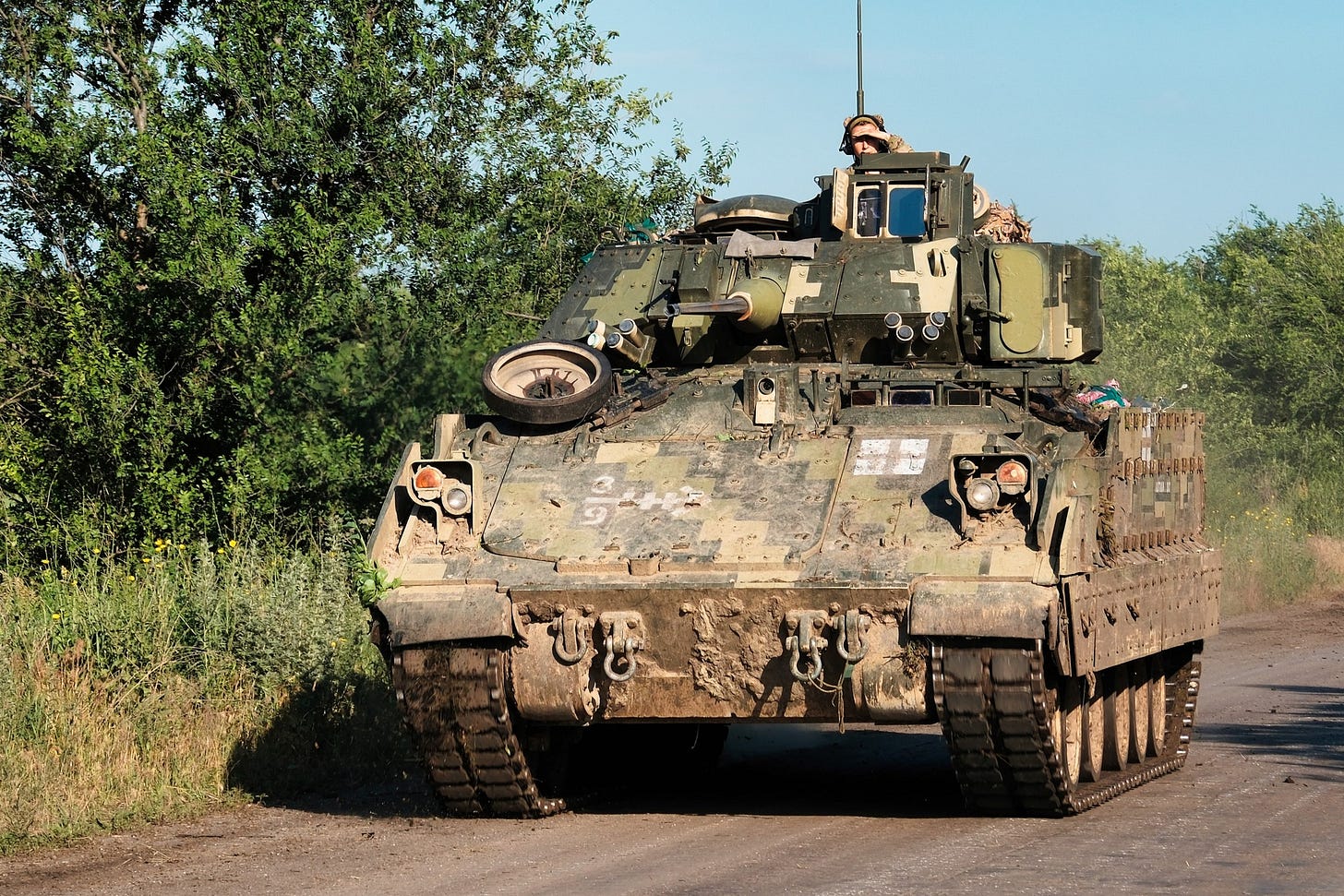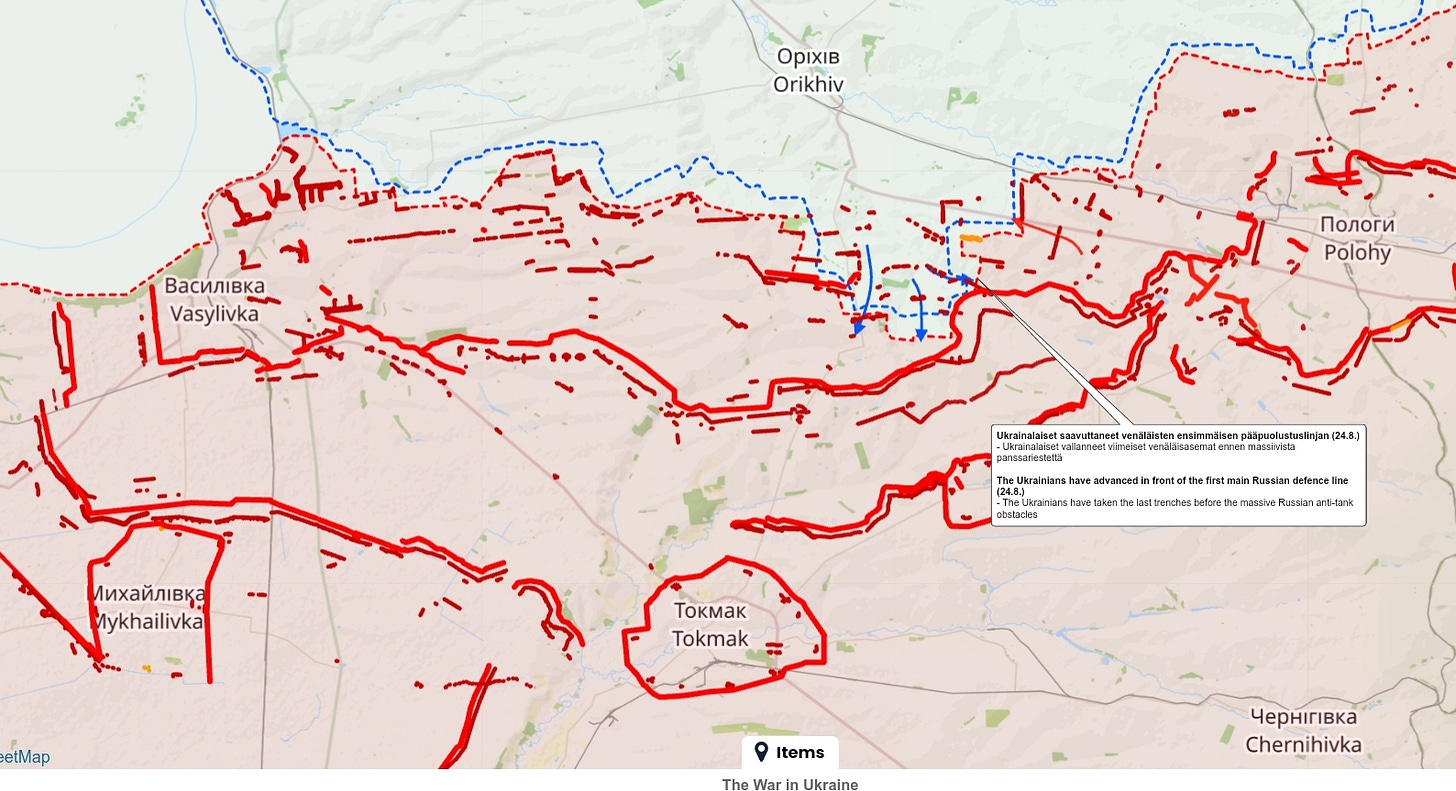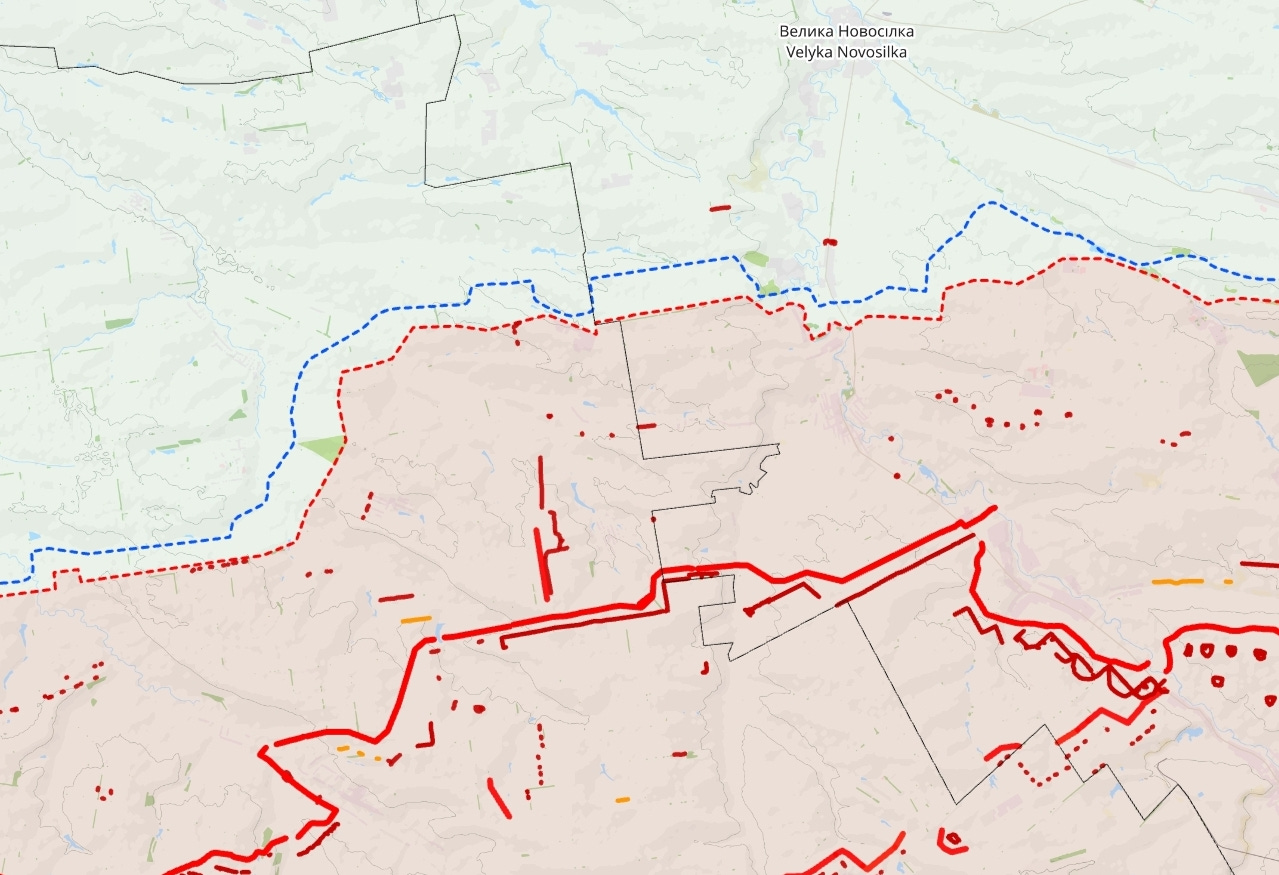Autumn Approaches: Part 1
Taking stock on the Ukrainian offensive before looking ahead
This article, the first of two, will build on previous Twitter posts and threads of mine, looking at where the war stands today and what factors has led to today's frontline situation. I think it's necessary to explain how I read the events of this summer and discuss some factors that have led us here, with focus on the Ukrainian offensive, before proceeding to look at what that will influence operations the coming autumn and winter. The latter will come in Part 2
The key event this summer is the still ongoing Ukrainian offensive and the discussion around it is heated. Much of the noise is generated by simplification into success vs failure. There is also a tendency to try to place blame somewhere. This is unhelpful, both in understanding why things have played out as they have and when looking ahead.
We don't know the details of the original Ukrainian plan, nor their timelines. Therefore there is some uncertainty regarding the metrics for determining success vs failure. One can focus on terrain recaptured or the rate of attrition, which can be hard to measure, or a combination of these two. However, going by both Ukrainian and Western statements along with the actual developments on the ground, it should be safe to say by now that the offensive didn't play out according to plan.
Now, let's begin by looking at how the situation along the frontline looks now, in late August.
Observed position: Progress in the south - Terrain focused
Despite continually grinding forward, Ukrainian progress in terms of terrain recaptured has so far been modest.
Frontline and Russian fortifications, August 25th, Orikhiv axis. By Black Bird Group
In the West, despite liberating Robotyne, fighting has yet to reach the first main defensive line in ernest. Getting this far, after a bloody start, has required two and a half months of heavy, bitter fighting and the commitment of most reserves dedicated to the offensive.
Frontline and Russian fortifications, August 25th, Velyka Novosilka axis. By Black Bird Group
Further east, while having pushed the Russians south of Urozhaine, there is still about 10km to the main defensive lines. There are indications now that the Velyka Novosilka axis will be de-prioritized in favor of the Orikhiv axis. At least there seems to be significant US pressure to do so.
Observed position: Attrition
After initial unsuccessful attempts at achieving a breakthrough, the fighting has mostly been of a grinding, attritional nature. In the media, this has often been dubbed as a change from “NATO style combined arms operations”, back to a more traditional Ukrainian approach, in part influenced by the Soviet heritage. One can debate whether this is a good comparison or not in this context. Attrition however, is and have been a key feature of this summer's battles and indeed the whole war. The difficulty with attrition as a metric is that it's hard to measure, especially in the open source domain.
On the positive side, the Ukrainians have increased the efficiency of their counter battery work, putting real pressure on Russian artillery.
Overall however, confirmed equipment losses are evenly matched going by the statistics compiled by naalsio26 on Twitter, as of August 18th, 348 Ukr vs 331 Rus losses. Ukrainian losses in personell has likely also been significant and has, in combination with equipment losses, led to the commitment of most units that were held in reserve for the offensive.
Ukraine has also by means of Storm Shadow and USVs been able to put some pressure on Russian logistics by striking, among other targets, the Chongar crossings and the Kerch Bridge, but overall impact of these strikes is hard to assess. Limited munitions availability leads to long periods between strikes, allowing the Russian to repair damage and mitigate the impact.
How has attrition affected Russian forces in the south? This is a question that is hard to answer with confidence. We have the confirmed equipment losses and personnel losses has likely been heavy. Except for the transfer of the 7th Guards Air Assault Division, there has been no significant transfers from other sectors.
My takeaway is therefore, that for now, the Russians have been and are are coping with the current level of attrition. For the future though, this is a very important factor, with a lot of uncertainty attached, so I'll return to this in Part 2
The rest of the frontline
Ukraine has kept up pressure around Bakhmut through the summer, though the tempo seems to have abated recently. This has resulted in the Russians gradually being pushed east and has tied up significant VDV elements, most notably large parts of the 98th and 106th Divisions and the 31st and 11th Air Assault Brigades.
In light of the offensive in Zaporizhzhia, this tying down of a number of VDV units is not insignificant, but as always, there is a cost / benefit trade-off. Again, this is something I'll return to in Part 2 as changes to the overall Ukrainian weight of effort will influence future developments.
Further north, the Russians have maintained pressure around Kreminna, Svatove, Kupyansk, with some gains. The most significant of these efforts, around Kupyansk, may be interpreted as an attempt to draw in Ukrainian reserves and prevent transfer of units to Zaporizhzhia.
These Russian operations also indicates, depending on what level of competence one attributes to the Russian General Staff, a belief that so far, major transfers of units to the south have not been needed to contain the Ukrainian offensive.
Artillery ammunition
The key metric in determining offensive potential in this war is the availability of artillery ammunition. Therefore, the US decision to donate DPICM was very important, giving access to a significant quantity of rounds, extending the timeframe of offensive operations.
Russian ammo shortages, especially compared to last year, are real, but Russian artillery remains remains very much in the fight.
Why are we here now?
As already stated, we do not know details about the original Ukrainian plans, nor Western input in making these plans though some details on the latter is coming out through anonymous US officials.
In regards to the heated discussion around the Ukrainian offensive, a lot boils down to too high expectations about what could be achieved and on what timeline. Ukrainian statments since the winter has played a part, but Western sources, commentators and pundits bear a responsibility in raising expectations too.
Too high expectations may have played a part in the lead-up, at least in US estimates of what could be achieved, going by statements in numerous recent articles in various outlets. A key thing to remember in this respect is that so far, neither side has managed to break through against determined resistace. Expectations on the impact of training in the West, focusing on “Western style” combined arms operations, may also have been too high.
As to how operations have played out on the ground, I see three groups of factors.
Internal AFU factors
The most important single factor here is that the Ukrainians struggle to conduct operations at scale. The largest we have seen are battalion attacks, but mostly there has been company- to platoon level operations. This means that the offensive mostly has been a series of individual actions the Russians can respond adequately too, not as synchronized larger operations that could have strained their response or even overwhelmed them.
Most units set aside for the offensive and given Western equipment are wartime raised, compromised mostly of mobilized personell. In the media, these units are often described as “NATO trained” but training in the West has been short by most standards and naturally focused a lot on learning how to operate new equipment. To expect these units to carry out combined arms operations at scale was prehaps never realistic. Many of the issues encountered at the tactical level should have been anticipated in advance because of this.
Wartime raised units, anywhere, will in most cases only receive a minimum level of training and due to attrition, have few experienced servicemen to lean on. This means learning on the job, making mistakes experienced units wouldn't, resulting in higher casualties. There is no easy way around this, it's a feature of high intensity war, but also a factor that should have moderated expectations. Seen together with the struggle to conduct operations at scale, one shouldn't expect units and groupings to achieve objectives, which in combination with other factors such as terrain and the enemy's capabilities, may be beyond their abilities.
A natural question is whether it would have been better pulling experienced units from the line and re-equipped them with Western equipment for the offensive. This should definitely be considered when the new substantial equipment donations arrive, but looking forward and at the current operations, we are where we are. There are some signs that experienced units are being given more important roles now than at the start of the offensive, though units not held in reserve has made valuable contributions from the start.
The Ukrainian shift towards slow, grinding operations makes sense because of what's started above, but it also means slow progress, casting doubt about what the offensive actually can achieve in terms of significant strategic and operational results.
The Russian defensive effort
NY Times article, August 22nd
I have a sense that the Russians and the challenges posed by their extensive fortified lines and minefields were underestimated prior to the offensive, at least in the public debate, prehaps also in professional circles. In the online discourse, many have ridiculed the fortifications since the Russians started digging last fall, but fortifications are- and have repeatedly been proven effective in this war. Much has been written on accompanying the minefields, so need to go into detail except to say they represent and have now been proven to be a formidable challenge.
The Russians are learning, adapting and fighting tenaciously for every meter of ground. This may not have gotten enough attention, especially in the West. Russian deficiencies tend to capture more attention than their successes. One can't base plans on the Russians collapsing, regardless of enticing that idea may seem.
Russian forces in the south have also been fighting according doctrine, in contrast to elsewhere, earlier in the war. They have a lethal mixture of ISR, ATGMs, aviation (especially rotary wing) and artillery. This, in combination with fortifications, mines and wide open terrain, negates many of the often talked about Russian deficiencies. They have also been able to rotate companies and battalions, an important measure for coping with attrition.
Any army would have struggled and taken heavy losses attempting to do what the Ukrainians are trying to do. One must also remember that the enemy always has a vote. Always.
Deficiencies and delays in Western support
Deliveries of AFVs came late and in low numbers to have the effect many seem to have expected. Quantity is a quality of it's own in the type of battles we are seeing and late deliveries had a not insignificant impact on training and preparations for the offensive as well.
Important capabilities are still withheld. While Storm Shadow has given some increase in long range capabilities, the numbers are low. Withholding other long-range systems has likely reduced the efficiency of deep strikes, which according to some analysts hasn't been a well syncronised, systematic campaign so far. It is important to state that no single system will be a game changer on it's own, but increased munitions availability will offer new possibilities, increasing friction for the Russian side.
As for Western training, there seems to be room for improvement in adapting the programs to Ukrainian needs. The AFU needs help scaling up current tactics, with focus on synchronization and coordination rather than adapting to Western practices. Solving this will require humility from both sides.
Battlefield air-defences is also a key issue, not easily solvable due to a lack of suitable systems, available in numbers, in the West. Most AD systems donated so far, such Patriot and NASAMS, are mainly used defending rear area targets that the Russians continue to strike. To solve the issue of battlefield AD, especially in countering attack helicopters and UAVs (including kamikaze variants), ingenuity from Western industry is required.
A short note on F-16s, since this is a hot topic these days. While this is important for the future of the Ukrainian Air Force, and should have come much sooner, I don't think this has been critical for the offensive. Operating Western fighters doesn't make the Ukrainian AF a “NATO AF" overnight. Reaching the full potential of fighter donations will take time, training and combat experience in a Ukrainian context. A lot also depends on setting up the maintenance organization and what munitions that will accompany the F-16s.
Summing up
There is no single reason why the offensive has developed as it has, but a combination of many factors. Weighting between my three main groups of factors isn't easy either, but I will claim that internal AFU issues and the Russian defensive effort have been more important than deficiencies in Western support. Thus, pointing fingers at the West may feel convenient, but is wrong and doesn't help Ukraine proceeding forward.
Discussing internal AFU soft factors may be uncomfortable, especially in Ukraine, but they are real and need to be addressed. Bringing up these issues isn't blaming Ukraine, but a necessary part of analyzing both what has been and what is coming, and I do this with Ukraine’s best interests in mind.
I feel that sharing my thoughts on events this summer was necessary before looking into the future, as I will in Part 2.
Here I will not only look at the prospects and possible outcomes of the offensive, but also a more general look at aspects and factors that will influence how the war develops going into autumn and towards the winter.
Regards
The Lookout





Succinct given the topics covered. Very readable. Thank you.
This is a good, sober analysis. Very Kofman-esque (or maybe Kofman's analysis is Lookout-esque) Either way, we need more like it.